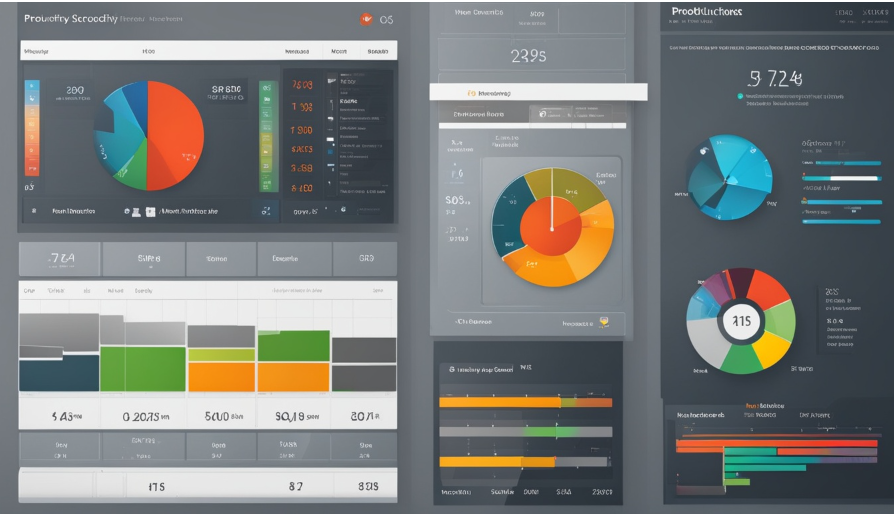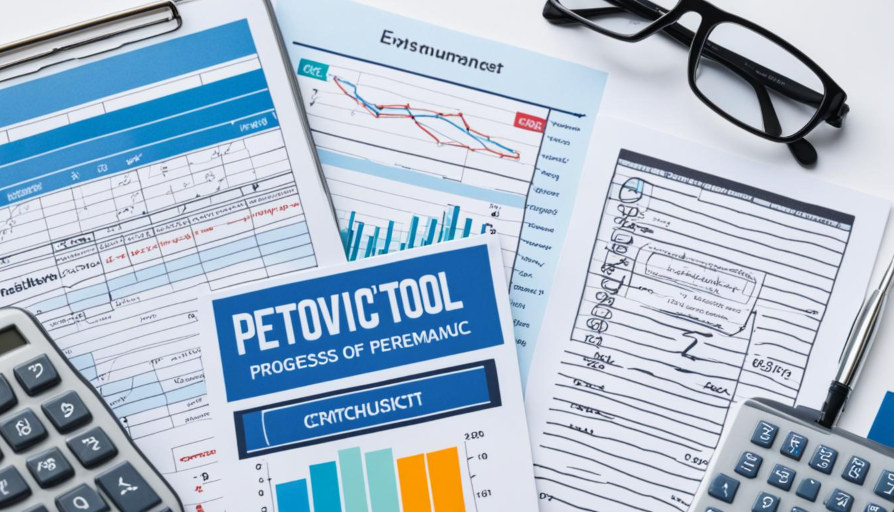Ensuring a business thrives requires tracking how well employees work. By examining productivity, businesses can boost profits and customer happiness. Human capital is a major asset. So, making the most of resources is critical. Employee productivity means how well staff do their jobs in given time frames.
Tools like Desklog accurately track employee efforts. These tools help managers make better plans and decisions. They also gauge how tasks are completed. It’s important to set goals for different job roles within a company.
Getting feedback from clients offers valuable insights into how employees are doing. It’s vital to look at both the amount and quality of work. Regular updates and open talks can boost work trends. Keeping an eye on employee health matters too for a full productivity review.
Considering past data and future trends helps set achievable goals. This makes sure that employee actions match company goals. A well-rounded view helps boost efficiency and happiness at work. It avoids the traps that lower actual work output.
Understanding Employee Productivity
Employee productivity is key to seeing how well employees work. It looks at their work quality and speed in hitting goals. This is true for all kinds of jobs, like making things, helping customers, and selling stuff.
In manufacturing jobs, we look at how much is made in an hour or how long it takes to make one thing.
What is Employee Productivity?
Employee productivity shows the work done versus the time and stuff used. In services, it’s about tasks done, customers helped, and meeting standards and deadlines. In sales, it’s about how much is sold, calls made, new accounts, and spending per sale.
Why is Measuring Productivity Important?
Checking productivity helps see if employees are engaged and skilled. It points out what needs fixing, like bad plans or unclear hints. Measuring work shows who is doing well or who needs help. It leads to better work habits and growth.
It gives a full picture of how well the workforce does. This helps the company do better and stay ahead. It also shows where training or extra help is needed, helping the company grow and make more money.
Set Clear Benchmarks
Setting clear benchmarks is very important. It helps measure and improve how well employees work. By setting these benchmarks, everyone knows what they should do. This makes sure everyone is doing their job right.
Establishing Standard Reference Values
To set these standards, we must define what success looks like for each job. Using a simple way to measure productivity, like results divided by effort, helps us see who is doing well. This makes it easy to spot areas that need work.
Setting Benchmarks for Different Roles
Setting benchmarks depends on the job. For some, it’s about how many tasks they finish each week. This way, we can compare different jobs easily. For sales jobs, we measure success by the money each employee makes.
We also look at time reports to understand team work and money made on projects. Using standards seen in key performance indicators helps set good goals. This makes sure goals are fair and keep us competitive.
Measuring work well and updating goals helps everyone know what is expected. This plan makes sure everyone does their part towards our common goals.
Focus on Task Completion, Not Hours Worked
Modern workplaces now focus more on what gets done, not on how long it takes. The Bureau of Labor Statistics found something interesting. The average office worker in the US actually works only 39% of their time.
This fact shows why we shouldn’t just look at work hours. Focusing on what we finish can help prevent burnout and stress. It means less time wasted and more meaningful work done.
Tools like MinuteDock help track time on tasks. They let bosses judge work by what gets done. This leads to better reviews and smarter time use.
This method also makes the workplace happier. People like it when their hard work is seen. It helps everyone play to their strengths and boosts team spirit.
Tracking tasks gives managers real info to act on quickly. Measuring work by tasks needs more data work, but it pays off. It offers deep insights into how well tasks are done.
In the end, looking at what’s done rather than time spent benefits the business. It makes for a workforce that’s more involved and productive.
Define Clear Business Goals and Objectives
Setting clear goals is key to increasing worker productivity. It lets employees know where to focus. They can see how their work helps the company grow. This kind of open communication builds trust and keeps employees motivated.
Importance of Short and Long-term Goals
Both short and long-term goals are important for progress. Short-term goals, running one to six months, keep teams motivated. The longer goals make sure efforts continue, aiming for big achievements.
Gallup studies show that short-term goals make employees more engaged. They see the value of their immediate work. Long-term goals, though challenging, motivate employees by offering a sense of achievement.
Aligning Employee Productivity with Business Goals
It’s crucial to match employee work with business targets. Performance tools help by making goal setting and tracking easier. These tools, along with feedback and metrics, show how goals are met. Including personal goals in company ones keeps everyone growing and engaged.
McKinsey suggests involving employees in setting these goals. This promotes commitment and productivity. It also nurtures top talent committed to the company’s future.
Utilize the Right Tools to Evaluate Employee Performance
Time tracking apps and productivity tools give insights. They show how staff handle tasks and their work progress. Features like automated screenshots make analyzing performance easier. This allows for better decisions on work and resources, boosting productivity.
Time Tracking Software
Apps like DeskTime track app use, idle time, and documents. This helps monitor how employees work and manage their time. These tools collect data automatically. They also find when employees are most productive. This info improves efficiency and shows where help is needed.
Automated Productivity Reports
Employee monitoring tools like Peoplebox provide easy performance reviews. They use platforms like Slack for reports. These reports show how much work is done. They stop employees from wasting time on sites like social media. Also, they find what tasks take too much time. This helps make work processes better.
IntelliHR offers performance dashboards with analytics. BambooHR allows for yearly employee reviews. These tools help keep track of how everyone is doing. Regular and effective evaluations foster a culture of growth. They help everyone do their best, no matter where they work.
Conduct Regular Client Surveys
Doing regular client surveys is key for businesses wanting to improve. These surveys are a major way to get customer opinions. This feedback helps make services better and strategies more client-focused.
Gathering Customer Feedback
Client surveys help in getting customer opinions in a structured way. This lets businesses know what clients need and expect. By responding to customer feedback, companies can make clients happier.
Improving Employee Performance Based on Feedback
Using survey data, businesses see where employees can do better. Customer opinions show what’s good and what’s not in the workforce. This lets businesses train their teams better and reward top workers.
Regular surveys make a business quick to adapt and respond. They close the gap between what customers expect and get. This keeps companies in the game and focused on customers.
Monitor the Quality of Work
High-quality work is crucial for productivity. Quality assurance measures are needed to check all work. These efforts improve products, raise morale, and increase happiness among customers.
Key Performance Indicators (KPIs)
KPIs are vital for assessing work quality. They are tailored for different job roles. These indicators help maintain high standards.
Assessments should use KPIs to guide training and development. By tracking mistakes and evaluating efficiency, companies set clear objectives. This leads to better accuracy and quality.
Balancing Quantity and Quality
Focusing on quality is as important as quantity. Setting quality goals for all teams creates achievable targets. Consistent feedback and understanding goals boost productivity.
ActivTrak’s software helps monitor performance precisely. Keeping policies written and communication frequent ensures standards are met.
How to Measure Productivity of Employees with Daily Updates
Daily updates are key to track how well employees work. They make performance clear and hold everyone accountable. These briefings help workers see their own progress.
Importance of Daily Updates
Daily check-ins are essential for watching how employees do. They offer feedback right when needed. This helps solve problems fast and keeps improving the workplace.
Real-time Reflection and Feedback
Feedback right away boosts morale and aligns goals. With daily updates, managers can give helpful advice and praise good work. This keeps everyone on track and improves the way we work.
Daily updates make our workplace better and quick to respond. They help catch issues early, keeping everyone moving forward. This leads to success for the whole company.
Encourage Open Communication
Creating a space where everyone feels free to talk is key in any organization. An open-door policy can help. It lets employees share their worries with bosses, which builds trust. But, making this happen can be hard.
Bosses sometimes don’t ask for ideas or properly listen. They might not act on what they hear. This can make people scared to speak up.
Workers really value being heard. They notice when companies say one thing but do another. So, bosses need to really listen and ask for thoughts regularly. Reflective listening shows that every opinion matters.
Managers should also connect with staff on more than just work. Being respectful when someone offers ideas helps a lot. Even if all suggestions aren’t used, saying “thank you” is important. It shows everyone that their voice counts.
Having regular meetings is a good move for bosses. They should share helpful feedback, not criticism. Dealing with issues quickly and well keeps trust strong. Happy and healthy workers do better at their jobs. They’re more productive and help out more.
Track Employee Well-being and Satisfaction
Employee happiness and satisfaction are key. They greatly affect how much gets done. Checking things like how often people are out sick helps. We can better understand their health.
It’s very important to have good mental health programs. This makes the workplace better for everyone.
Absenteeism and Presenteeism
Looking into why employees miss work shows us a lot. Stress or feeling sad can be big reasons. When people work sick, productivity drops a lot.
Feeling down can lead to missing 32 days of work a year. The cost of this is more than healthcare expenses. Offering mental health help and flexible work can reduce these problems. Up to 87% of workers like having flexible options.
Mental Health Checks
Regular mental health check-ups boost job happiness. About 80% of workers think these checks can prevent serious issues. Almost 73% of staff and 81% of bosses prefer to stay in companies that care about mental health.
Focusing on mental health lowers missed work days. It makes employees happier and more engaged too.
Conduct Comparisons Across Similar Roles
Comparing performance across similar roles helps spot top talent. It shows how each person’s work measures up. By looking at tasks done, work accuracy, and quality, companies learn a lot.
They figure out who does best. This helps set good goals and lift performance. It makes the entire team better.
Identifying Top Performers
Finding and praising top workers boosts a winning culture. Comparing performance helps see who shines. It’s all about the numbers, making praise fair and clear.
Using software, employers can track and analyze work data easily. This makes sure everyone is judged fairly.
Internal Motivation and Employee Recognition
Wanting to do well is key for keeping productivity up. Rewarding hard work matters a lot. It makes people more involved and eager.
Giving awards to the best workers motivates everyone. It helps everyone aim for the stars. This boosts happiness and encourages a team spirit.
Conclusion
Measuring employee productivity is complex and needs a careful plan. It involves setting clear goals, using the right tools, and checking work quality. Using time-tracking software like Timeular and TrackoField helps. These tools track how long tasks take and how well employees do in the field.
It’s also key to make sure employees understand business goals. When employees know their targets, they work better. Tracking how quickly tasks are done helps see how teams are doing. EmpMonitor is great because it helps manage projects and track progress in real time.
To stay successful, companies must keep checking and updating their productivity methods. High productivity makes for a better use of resources and happier employees. Employing these strategies helps reach company goals and builds a culture where everyone wants to do better and feels valued.
FAQ
What is Employee Productivity?
Employee productivity looks at how well and how quickly employees do their tasks. It measures the efficiency and quality of work they do. This is done to reach business goals within a certain time and keep up standards.
Why is Measuring Productivity Important?
Knowing how productive employees are is key. It tells us about their engagement and skills. It helps with planning, encourages responsible work, and pushes for better results. Measuring it right keeps businesses competitive.
How do you Establish Standard Reference Values for Productivity?
To set standard productivity values, we look at expected metrics for each job. These benchmarks let us compare performance. They help match results with what the business expects.
Why Should Productivity Focus on Task Completion and Not Hours Worked?
Focusing on finishing tasks instead of counting hours stresses the importance of work quality and speed. This makes employees aim to work smarter to reach business goals.
How Do Clear Business Goals Impact Employee Productivity?
Clear goals show employees what they need to do and how it helps the company. These goals motivate and guide them. This ensures everyone works towards the same objectives.
What Tools are Useful for Evaluating Employee Performance?
To check on employee performance, tools like time trackers and productivity apps are key. They show how well tasks are managed and work is done. This makes reviewing performance and allocating resources easier.
How Can Client Surveys Improve Employee Performance?
Client surveys give feedback on how happy customers are and the quality of service. This feedback helps improve employee skills, rewards good work, and promotes customer focus in the workplace.
How Do You Monitor the Quality of Work?
To watch work quality, we set Key Performance Indicators (KPIs) for jobs. KPIs help ensure tasks are done well and on time. They help keep quality high without losing productivity.
What is the Importance of Daily Updates in Measuring Productivity?
Daily updates let us see how employees are doing and spot trends. This leads to quick feedback, reflection, and better work habits. It makes the whole team more productive.
How Does Open Communication Impact Productivity?
Open talk in the workplace makes a culture where everyone feels heard. This leads to trust, faster problem-solving, better morale, and higher productivity.
Why is Tracking Employee Well-being and Satisfaction Important?
Understanding employee health and happiness helps prevent work issues. This supports a caring work environment. It makes employees happier and keeps them productive.
How Do You Compare Performance Across Similar Roles?
Comparing workers in similar jobs shows us who does best and who needs more help. Reward systems based on these findings motivate everyone to do better. This creates a great workplace culture.

More Posts
10 Best Books on Time Management to Read
Are you struggling to do more in less time and looking where to start from? You have come to the right place, and we would love to help you with that. Accomplishing this...
11 Monthly Planning Tips to Prepare for Holidays
Christmas is getting closer, and preparing well is key. With only 12 weeks left, using smart monthly planning tips is essential. It makes getting ready for the holidays easier and less stressful. There...
How to Improve Focus and Concentration at Work
Distractions at work can severely damage your productivity and work-life balance. Many people get more easily distracted than others. Staying focused at work can be a challenge for them, even when they are...
11 Essential Elements of a Successful Partnership Meeting
A successful partnership meeting is a key strategic tool that enhances collaboration, drives decision-making, and reinforces shared objectives. In today's fast-paced professional environment, Zippia research indicates that an average worker spends 31 hours...



